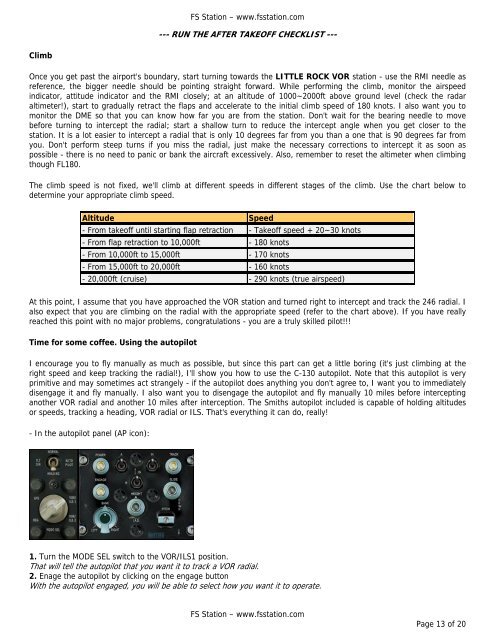Captain Sim 'Legendary C-130' - Flight Tutorial - e-HAF
Captain Sim 'Legendary C-130' - Flight Tutorial - e-HAF
Captain Sim 'Legendary C-130' - Flight Tutorial - e-HAF
Create successful ePaper yourself
Turn your PDF publications into a flip-book with our unique Google optimized e-Paper software.
FS Station – www.fsstation.com--- RUN THE AFTER TAKEOFF CHECKLIST ---ClimbOnce you get past the airport's boundary, start turning towards the LITTLE ROCK VOR station - use the RMI needle asreference, the bigger needle should be pointing straight forward. While performing the climb, monitor the airspeedindicator, attitude indicator and the RMI closely; at an altitude of 1000~2000ft above ground level (check the radaraltimeter!), start to gradually retract the flaps and accelerate to the initial climb speed of 180 knots. I also want you tomonitor the DME so that you can know how far you are from the station. Don't wait for the bearing needle to movebefore turning to intercept the radial; start a shallow turn to reduce the intercept angle when you get closer to thestation. It is a lot easier to intercept a radial that is only 10 degrees far from you than a one that is 90 degrees far fromyou. Don't perform steep turns if you miss the radial, just make the necessary corrections to intercept it as soon aspossible - there is no need to panic or bank the aircraft excessively. Also, remember to reset the altimeter when climbingthough FL180.The climb speed is not fixed, we'll climb at different speeds in different stages of the climb. Use the chart below todetermine your appropriate climb speed.AltitudeSpeed- From takeoff until starting flap retraction - Takeoff speed + 20~30 knots- From flap retraction to 10,000ft - 180 knots- From 10,000ft to 15,000ft - 170 knots- From 15,000ft to 20,000ft - 160 knots- 20,000ft (cruise) - 290 knots (true airspeed)At this point, I assume that you have approached the VOR station and turned right to intercept and track the 246 radial. Ialso expect that you are climbing on the radial with the appropriate speed (refer to the chart above). If you have reallyreached this point with no major problems, congratulations - you are a truly skilled pilot!!!Time for some coffee. Using the autopilotI encourage you to fly manually as much as possible, but since this part can get a little boring (it's just climbing at theright speed and keep tracking the radial!), I'll show you how to use the C-130 autopilot. Note that this autopilot is veryprimitive and may sometimes act strangely - if the autopilot does anything you don't agree to, I want you to immediatelydisengage it and fly manually. I also want you to disengage the autopilot and fly manually 10 miles before interceptinganother VOR radial and another 10 miles after interception. The Smiths autopilot included is capable of holding altitudesor speeds, tracking a heading, VOR radial or ILS. That's everything it can do, really!- In the autopilot panel (AP icon):1. Turn the MODE SEL switch to the VOR/ILS1 position.That will tell the autopilot that you want it to track a VOR radial.2. Enage the autopilot by clicking on the engage buttonWith the autopilot engaged, you will be able to select how you want it to operate.FS Station – www.fsstation.comPage 13 of 20
















